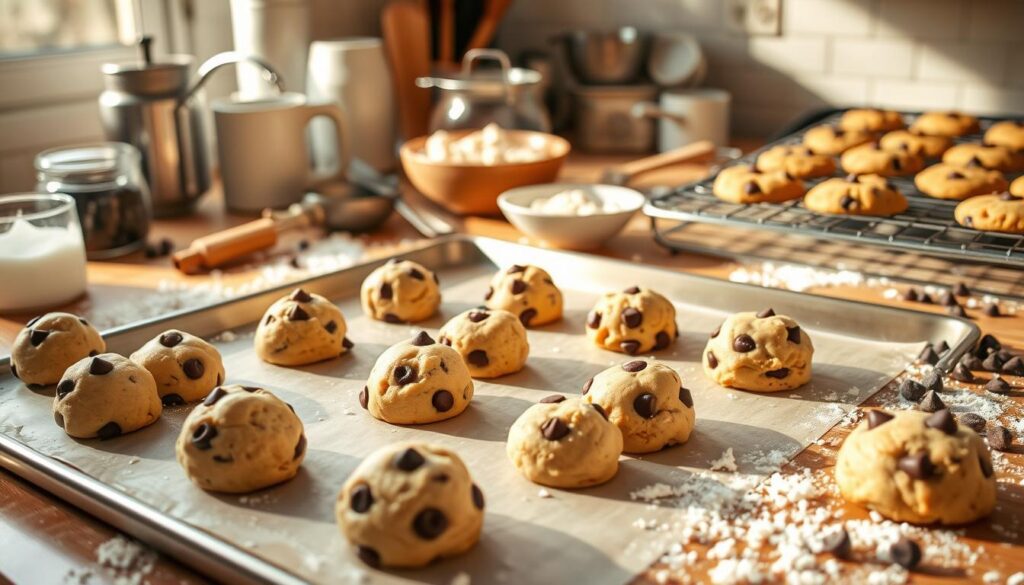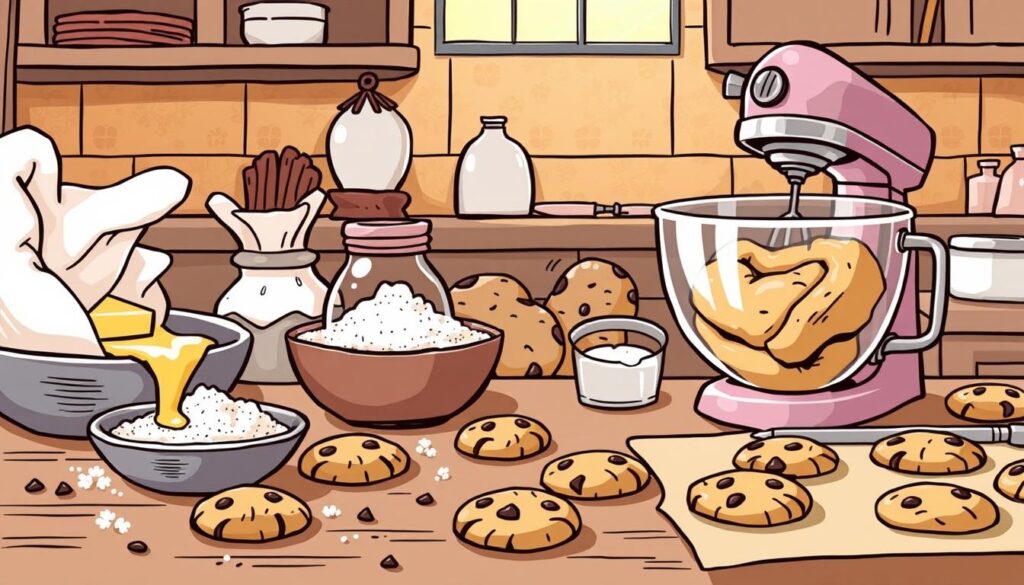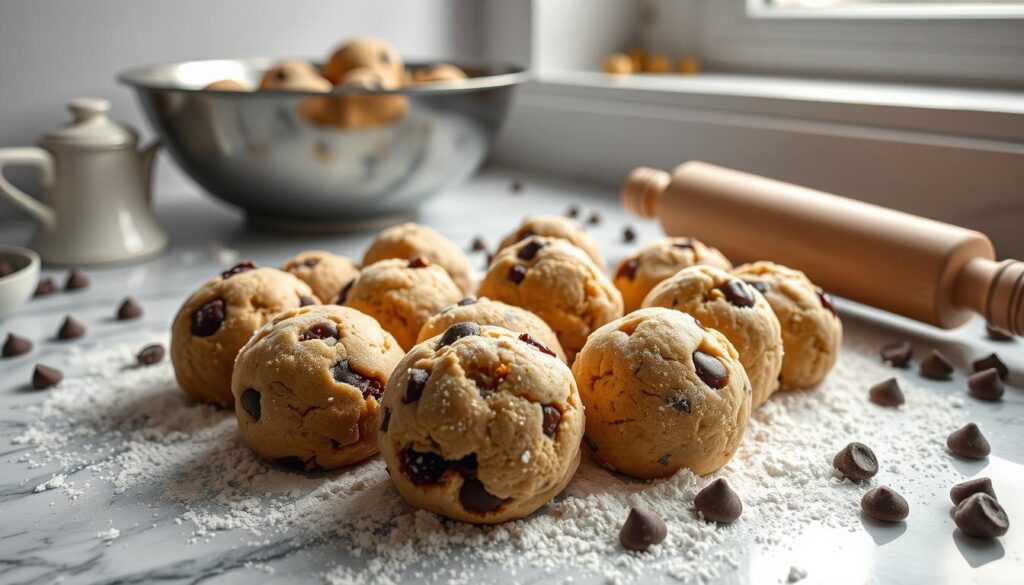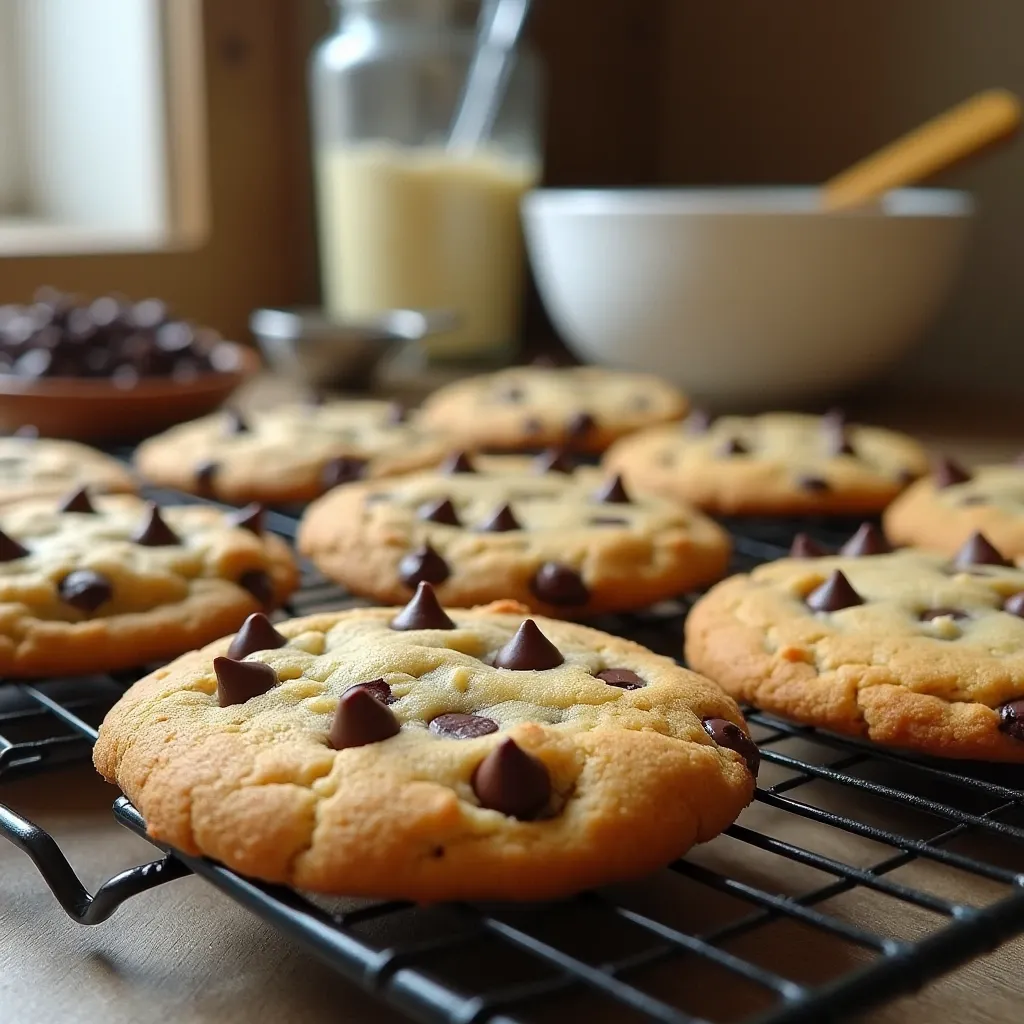Flat chocolate chip cookies are a big problem for many bakers. If you’ve tried the Nestle recipe but got disappointing results, you’re not alone. To avoid flat cookies, focus on technique and the right mix of ingredients.
With the right baking tips, your cookies will be thick and tasty. They won’t be flat and boring.

Key Takeaways
- Chilling cookie dough overnight can significantly enhance cookie thickness.
- Using a silicone baking mat or parchment paper can prevent excessive spreading.
- Rolling cookie dough into taller balls aids in creating sturdier cookies.
- The type and color of your baking sheet influence spreading outcomes.
- Properly measuring ingredients is key for keeping cookies thick.
- Letting baking sheets cool between batches stops the base from burning.
The Common Causes of Flat Chocolate Chip Cookies
Baking the perfect chocolate chip cookie can be tough. Many people search for ways to avoid flat cookies online. Knowing common mistakes can help you get the chewy texture we all love. Several things can make cookies flat, from how you measure ingredients to your baking environment.
Using too much butter is a big problem. Over-creaming butter and sugar weakens the cookie, making it flat. Make sure butter is soft, ideally at room temperature for 30 minutes. Or, cut it into small pieces and let it sit for 15 minutes for the right mix.
Getting the right amount of sugar and flour is key. Too much sugar makes the dough too wet, causing it to spread. Measuring ingredients carefully is important for your cookie’s success. Using fewer chocolate chips can also help keep cookies thick.

The place where you bake matters a lot. Too much humidity can add too much moisture to the dough. Make sure to leave enough space between cookies on the tray for air to flow. Letting baking sheets cool between batches helps prevent cookies from spreading or burning.
Checking your oven’s temperature is also important. An oven thermometer can help prevent fat from melting too fast. Keeping these tips in mind can help you bake thicker, tastier cookies.
Understanding the Importance of Chilling Dough
Chilling cookie dough is key to making perfect cookies. It changes the texture and flavor. Chilling makes cookies taste richer and have a better feel.
Why Chilling is Crucial for Cookie Structure
Chilling the dough helps cookies keep their shape. Even a 30-minute chill can make a big difference. Longer chilling, like 24 to 72 hours, makes cookies chewier and tastier.
Butter-rich cookies need chilling to avoid spreading too much. Cold butter melts slower, keeping cookies in shape. As the dough cools, flavors get stronger. This makes cookies chewy, not soft.
Chilling also makes dough sweeter and more flavorful. Chocolate chip cookies get even better with age. After 10 days, they’re darker and taste stronger.

But not all cookies should chill for too long. Oatmeal cookies should chill for 48 hours max. Chilling is essential for texture and flavor. It makes cookies better in every way.
How to Keep Chocolate Chip Cookies From Flattening?
Making chocolate chip cookies the right shape can be tricky. But, there are ways to stop them from getting flat. By using these tips, your cookies will stay thick and tasty, making every bite a joy.
Key Techniques to Avoid Flat Cookies
Here are some methods to keep your cookies thick and fluffy:
- Chill Your Dough: Chill the dough for 24 hours or more. This makes the cookies thicker and more flavorful.
- Freeze Dough Balls: Freeze the dough into balls for 10 to 15 minutes before baking. This helps them keep their shape.
- Avoid Over-Greased Baking Sheets: Too much grease can make cookies spread too much. Use just enough to prevent sticking.
- Manage Your Baking Sheet Count: Put 12 cookies on each tray. This lets them bake evenly without getting too flat.
- Watch the Weather: High humidity can make cookies flat. Adjust your baking plan if it’s humid outside.
- Check Leavening Agents: Make sure your baking soda and powder are fresh. Old ones can stop cookies from rising.
- Measure Ingredients Accurately: Measuring right is key. Too little of anything can make cookies spread too much.
- Butter Temperature Matters: Use softened butter, not melted. This keeps the cookies from spreading too much.
- Experiment with Shortening: Try using shortening instead of butter. It has a higher melting point, which helps cookies stay thick.
- Mix-Ins Influence Texture: Adding nuts or oats can make cookies thicker and more dense. This helps prevent them from getting flat.
Choosing the Right Baking Sheet
Choosing the right baking sheet is key for perfect cookies. Different materials affect how cookies bake and shape up. Knowing this helps pick the best sheets for cookies.
Materials and Their Effects on Baking
Cookie baking sheets come in many materials, each with its own impact. Here are three common types and what they do:
| Material | Effect on Baking | Recommendations |
|---|---|---|
| Dark Metal | Tends to absorb heat quickly, causing cookies to bake faster and possibly over-bake. | Use with caution. Monitor closely to prevent burning. |
| Light Metal | Provides a more even bake and helps cookies rise without excessive spreading. | Choose for optimal results, when baking multiple trays. |
| Baking Mats (Silicone or Parchment) | Offers a nonstick surface but can encourage spreading based on the material. | Silicone mats work well, but parchment may yield better results in preventing unwanted spreading. |
Brands like USA Pan are top picks for their durability and heat distribution. Don’t over-grease your sheet; too much can make cookies spread too much.
Measuring Ingredients Accurately
Getting the right amount of ingredients is key to baking success. When making chocolate chip cookies, being precise is very important. It affects the cookie’s texture and shape. Knowing the right ratios of ingredients is vital to avoid flat cookies.
Follow these tips to keep your cookies just right:
Why Precision Matters in Baking
Measuring ingredients correctly helps prevent cookies from spreading too much. Too little flour or leavening can ruin the cookies. Here are some tips to improve your baking:
- Use weight measurements when possible. A digital scale is the most accurate.
- Spoon and level flour to avoid packing it down, which adds too much.
- For thicker cookies, add 2 tablespoons (15 grams) of flour, or up to an extra ¼ cup (31 grams) if needed.
Also, keep an eye on your ingredients’ temperature. Butter should be cool to the touch. Don’t overmix the dough, as it can make the cookies fall apart.
| Measurement Type | Recommended Technique |
|---|---|
| Flour | Spoon and level to avoid packing |
| Sugars | Packing brown sugar, measuring granulated by leveling |
| Liquids | Use liquid measuring cups for accuracy |
| Butter | Cool room temperature, cutting into small pieces for rapid softening |
With careful measurement, you can bake perfect cookies. Chilling the dough helps prevent spreading. Using cool baking sheets also keeps cookies thick. Make sure to leave enough space between cookies for even baking. These tips will help you bake delicious cookies every time.
The Role of Butter in Cookie Dough
Butter is key in making chocolate chip cookies just right. Its temperature affects the cookie’s texture and structure. Knowing the right butter temperature is vital for the perfect cookie.
Butter should be soft but not melted. This keeps the dough from being too runny. Too runny dough can make cookies flat.
How Temperature Affects Butter’s Performance
Here are some tips for the best cookie dough:
- Let butter sit at room temperature for about 30 minutes to soften.
- Avoid overheating butter, as it can lose structure.
- Use cold butter for thicker cookies.
- Cool cookie sheets between batches to keep the right temperature.
The right butter temperature is more than just flavor. It affects how cookies rise and keep their shape. The wrong temperature can ruin everything:
| Butter Temperature | Effects on Cookie Texture |
|---|---|
| Softened | Results in a chewy and well-structured cookie. |
| Melting | Causes excessive spreading and flat cookies. |
| Cold | Can lead to thicker cookies with less spread. |
Handling butter correctly ensures cookies rise well. This keeps their shape and texture appealing. Paying attention to these details prevents flat cookies.
What to Do About Leavening Agents
Leavening agents in cookies are key for texture and rise. Using baking soda and fresh baking powder right is vital. Bad leavening agents can make cookies flat and dense.
Testing baking soda and powder is simple. It checks if they work well.
Testing for Freshness and Effectiveness
To check if your leavening agents are good, do these tests:
- Baking Soda Test: Mix a teaspoon of baking soda with vinegar. If it fizzes a lot, it’s fresh.
- Baking Powder Test: Mix a teaspoon of baking powder with hot water. If it bubbles a lot, it’s good.
Old leavening agents won’t make your cookies rise right. Check expiration dates to avoid flat cookies. Testing baking soda and powder often keeps your ingredients working well.
| Leavening Agent | Freshness Test | Effect on Cookies |
|---|---|---|
| Baking Soda | Vinegar fizz reaction | Provides rise when reacting with acids |
| Baking Powder | Hot water bubbling reaction | Releases gas for rising during baking |
Using fresh leavening agents makes cookies better. Knowing how they work in your recipe is key for perfect cookies.
Using Optional Add-Ins for Better Texture
Adding optional ingredients can make chocolate chip cookies better. These add-ins add flavor and help the cookies keep their shape. They make the cookies chewy and delicious.
How Extras Like Nuts and Oats Affect Cookies
Nuts or oats can make cookies thicker and chewier. They stop cookies from spreading too much. Without these, you might need more flour to keep them from getting flat.
| Cookie Add-In | Effect on Texture | Flavor Contribution |
|---|---|---|
| Nuts (e.g., walnuts, pecans) | Adds crunch and can provide stability | Offers a rich, earthy flavor |
| Oats | Contributes a chewy texture and heartiness | Imparts a subtle nutty flavor |
| Chocolate Chips | Enhances gooeyness and melts during baking | Rich chocolate flavor boosts overall sweetness |
| Shredded Coconut | Adds chewiness and moisture | Gives a tropical, sweet note |
Using these ingredients right can make chocolate chip cookies special. They become a treat you’ll want to enjoy.
Techniques for Proper Mixing
Mixing cookie dough right is key to baking perfect cookies. The goal is to mix well but not too much. This avoids overmixing, which can ruin the cookies. Using the right mixing techniques helps keep the dough firm and the cookies in shape.
Knowing how overmixing affects dough helps bakers. It lets them mix with confidence.
Avoiding Overmixing and Its Effects
Overmixing cookie dough is bad. It can make the dough weak. This can cause cookies to spread too much and not rise right.
To avoid these problems, try these tips:
- Mix ingredients just until they come together; don’t overbeat.
- Use a stand mixer or high-powered electric mixer for better control.
- Make sure butter is soft, around 65°F to 68°F, for easier mixing.
- Chill the dough for at least an hour to make it firmer before baking.
By following these mixing tips, bakers can help their cookies rise well. This makes baking more enjoyable.
| Technique | Description |
|---|---|
| Balanced Mixing | Mix the ingredients until just combined to prevent excessive air incorporation. |
| Temperature Control | Use softened butter (65°F to 68°F) for optimal mixing and dough structure. |
| Dough Refrigeration | Chill the dough for at least an hour to solidify and stabilize the mixture. |
| Proper Equipment | Utilize a stand mixer or electric mixer to manage mixing time accurately. |
Cooling Between Batches
Cooling cookie sheets between batches is key for perfect cookies. Hot sheets cause dough to spread too much, making cookies flat. Let the sheets cool between batches for the best results.
Importance of Room Temperature Baking Sheets
Cooling is very important. Here are some key points about cooling:
- Wait at least ten minutes after each batch to let sheets cool.
- Space cookies well on the sheet—ideally 12 per tray—to help them bake evenly.
- Flat cookies can come from greasy sheets or wrong ingredient ratios.
Chilling dough is very important. For example, chilling dough for 24 hours can make it better. Freezing it for 10 to 15 minutes before baking helps too. This keeps cookies from burning and bakes them evenly.
| Cooling Process | Time Required | Effect on Cookies |
|---|---|---|
| Cooling Baking Sheets | 10 minutes | Prevents immediate spreading |
| Refrigerating Dough | 24 hours | Increases chewiness and crispness |
| Quick Chill in Freezer | 10-15 minutes | Results in thicker cookies |
Managing cooling of baking sheets well can make cookies thicker and tastier. Understanding cooling is key to better baking and more joy in your work.
Conclusion
Let’s wrap up our talk on keeping chocolate chip cookies from getting flat. We’ve covered key tips, from handling ingredients to controlling temperature. These small changes can make a big difference.
Understanding butter temperature, measuring right, and chilling dough are key. They help prevent flat cookies. By following these steps, you can make your cookies better.
Using the right techniques will help you bake perfect chocolate chip cookies every time. Avoid overmixing or undermixing. Also, use room-temperature baking sheets for the right texture.
Try different baking temperatures and ingredient mixes. These can change your cookie’s texture a lot. Remember, practice and patience are important.
Keep these tips in mind as you get better at baking. Soon, you’ll be making delicious, thick cookies. Enjoy the journey and the tasty results of your hard work!
FAQ
What are the common causes of flat cookies?
Flat cookies can happen for many reasons. Using warm butter or wrong oven temperatures is one. Not enough flour or wrong leavening agents also cause it. Humidity can play a part too.
Why is it important to chill cookie dough?
Chilling dough stops cookies from spreading too much. Cold dough keeps its shape better. Chilling it overnight is best for thick cookies.
What techniques can I use to prevent my cookies from flattening?
To keep cookies thick, make dough balls tall. Use room temperature baking sheets. Freezing dough balls before baking helps too.
How does the choice of baking sheet affect cookie results?
Baking sheet material matters a lot. Dark metal sheets can overcook cookies. Lighter, sturdy sheets like USA Pan work better. Don’t grease too much to avoid spreading.
Why is precise ingredient measurement essential in baking?
Measuring ingredients right is key. Use spoons or digital scales for flour. Small mistakes can ruin cookie texture.
How does butter temperature influence cookie dough?
Butter should be soft but not melted. Soft butter helps cookies rise. Melted butter makes them flat.
How can I test my leavening agents for freshness?
Check baking powder and soda with a vinegar test. If they fizz, they’re good. No fizz means they’re old and need replacing.
What optional add-ins can improve cookie texture?
Nuts, oats, or more chocolate chips can help. If not using these, more flour can also prevent flatness.
Why should I avoid overmixing cookie dough?
Overmixing adds too much air. This weakens dough and makes cookies fall. Mix just enough for a firm dough.
How long should I let baking sheets cool between batches?
Let sheets cool for at least ten minutes. This stops dough from spreading too much and keeps cookies thick.

